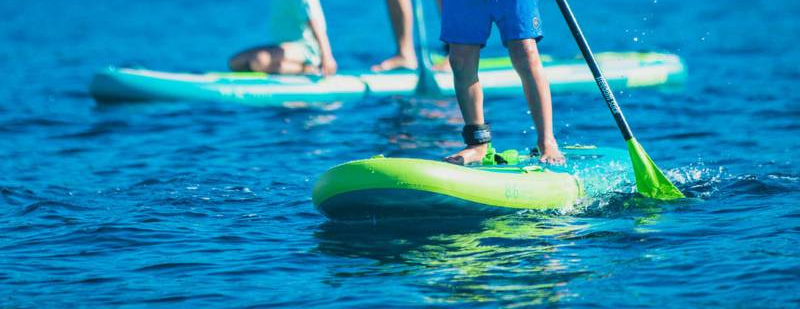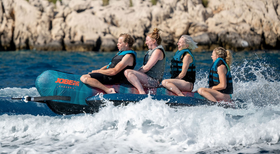
Understanding Nose and Tail Rocker in Paddleboards
When it comes to stand-up paddleboards (SUPs), the terms "nose rocker" and "tail rocker" are crucial for understanding how a board performs on the water. These design features significantly influence a board’s handling, stability and suitability for various paddling conditions.
Let’s dive deeper into what these terms mean and how they impact your paddling experience.
What is a Nose Rocker?
Nose rocker refers to the upward curve of the board’s front end (the nose) when it is laid flat on the water. Essentially, it’s the angle at which the nose lifts away from the water surface. A board with more pronounced nose rocker will have a higher angle, while one with less rocker will sit flatter.

Benefits of a Nose Rocker
- Improved Manoeuvrability: A board with significant nose rocker is easier to turn and pivot, making it ideal for navigating tight spaces or performing tricks.
- Enhanced Performance in Choppy Conditions: The lifted nose helps the board glide over waves and chop, reducing the chance of nosediving. This feature is particularly beneficial for ocean paddling or when dealing with rough waters.
- Better Tracking: A moderate amount of nose rocker allows the board to cut through water more efficiently, improving tracking during paddling.
Which Nose Rocker is best for me?
Moderate Nose Rocker
Commonly found on all-around boards, a moderate nose rocker strikes a balance, making it suitable for a range of activities, including flatwater paddling, ocean exploration, yoga and fishing. This versatility makes it a popular choice for recreational paddlers.
High Nose Rocker
Boards with high nose rocker are tailored for specific conditions, such as whitewater and river surfing. This design ensures that the nose remains above the water, allowing the board to channel moving water without submerging. However, a high nose rocker can create increased air resistance, making it less efficient on flatwater.
Low Nose Rocker
Typically found on racing or long-distance touring boards, low nose rocker enhances glide by maximizing the flat surface area in contact with the water. An extreme example is a board with zero rocker, which features a completely flat profile. See example below of the Aqua Marina aqua Hyper Touring SUP. While this design increases efficiency on calm waters, it may compromise stability.

What is a Tail Rocker?
Tail rocker is the opposite of nose rocker and refers to the upward curve at the rear end (the tail) of the board. Similar to the nose rocker, the angle of the tail’s curve can affect how the board behaves in the water.
Slight Tail Rocker
A small amount of tail rocker can facilitate smoother turns with less resistance, which is beneficial in certain paddling conditions. However, this feature can also slow the board down, which is why many touring and all-around boards opt for straight tails with minimal or no tail rocker.
Banana Rocker
This specialised design features continuous curvature from the nose to the tail, primarily found on whitewater SUP boards. It allows the board to conform to the contours of waves, preventing the nose or tail from diving under. This design enables riders to shift their positioning and adapt to varying conditions on the water.

Benefits of Tail Rocker
- Increased Stability: A board with a bit of tail rocker can offer better stability, especially when paddling in rough conditions. The design helps the board sit more comfortably on the water’s surface.
- Enhanced Control During Turns: Tail rocker makes it easier to initiate turns and manoeuvre the board, which is particularly helpful for those who enjoy surfing or riding waves.
- Performance in Surf: When riding waves, tail rocker allows for a smoother transition from flat water to the wave face, helping to maintain speed and control.
Finding the Right Balance
The amount of nose and tail rocker you choose should depend on your intended use for the paddleboard.
-
For Beginners: A board with a moderate amount of nose and tail rocker can provide a good balance of stability and manoeuvrability, making it easier for novice paddlers to learn.
-
For Recreational Use: If you plan on exploring calm lakes or rivers, look for a board with less rocker for better tracking and efficiency.
- For Surfing or Choppy Conditions: If you’re looking to paddle in the ocean or surf small waves, a board with more pronounced rocker in both the nose and tail will enhance performance and help you navigate through challenging conditions.

Jobe's Paddleboard statistics
Most recreational paddleboards feature a high nose rocker and flat tail, which makes them pretty versatile for all skill and age levels. An example are Jobe's new SUPs. Compare SUP type with size and rocker details below. Jobe has kept nose rockers on the Duna touring SUPs at medium height. It's the shape that defines it as a touring SUP (compare Jobe Loa (left) and Jobe Duna (right) below). This makes them an excellent choice for paddlers transitioning into a more specialised paddling experience.


In conclusion…
If you're primarily paddling for leisure, you might not need to delve deeply into rocker profiles. However, if you are looking to optimise your performance based on specific activities, racing, whitewater or surfing, examining the rocker design can make a significant difference in how your board performs.
By considering the rocker profiles, you can make an informed decision and choose a paddleboard that aligns with your paddling style and adventures.
Happy paddling!


